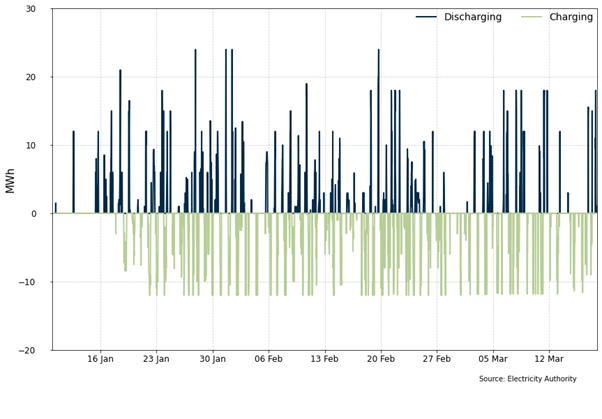Eye on electricity
Unlocking the potential for batteries to contribute to security of supply
- Consumers
- Generation
This article explains the importance of grid-scale batteries as New Zealand shifts towards a highly renewable electricity system.
What is grid battery storage and why is it important?
New Zealand is building more renewable electricity generation. However, renewable generation (like wind and solar) vary with the weather, so renewable electricity supply may not match up with demand. Grid scale batteries soak up excess renewable electricity, and then release it back to the grid when needed. Some batteries also provide extra services like reserves.
Grid-scale batteries maximise the benefits of renewable energy and provide extra resilience during times of tight electricity supply. Additionally, these batteries, alongside more renewable generation, will help off-set the retirement of thermal generation and support New Zealand’s transition to a low-emissions economy.
New Zealand’s first grid-scale battery in the Waikato
The first grid-scale battery was commissioned in 2023 by Hamilton lines company WEL Networks. It is located near Huntly power station and began charging and discharging into the grid in 2024. The size of the battery is 35MW (35MWh), which is enough to meet the daily demand for 2,000 homes.
Batteries charge when prices are low, and discharge when they are high
Grid-scale batteries work by buying electricity, storing it and then selling it back. The battery operators use half-hourly electricity spot prices to decide how they will buy, store and sell electricity. The battery charges when intermittent renewable generation (like wind or solar) is high and demand is low, which usually results in low spot prices. The battery is then discharged when demand and spot prices are high, usually in the early mornings and evenings. If batteries discharge into the grid when prices are above its charging cost, then it will ensure the battery pays itself back over time.
Figure 1 shows when WEL Networks battery was charging and discharging. From 10 January to 17 March 2024, WEL Networks' battery discharged into the grid during 473 trading periods (13% of the time) and charged during 625 trading periods (17% of the time). From January to March 2024, the mean discharging spot price was $236/MWh and the median was $219/MWh. The mean charging spot price was $123/MWh and the median was $132/MWh.

More grid-scale batteries are on the way
As New Zealand electrifies, more grid-scale batteries will support the growing renewable energy supply. Meridian Energy is building a 100MW (200MWh) battery near Ruakākā in sunny Northland. This battery is expected to be commissioned in September 2024. Meridian is planning a 130MW solar array on the same site.
Genesis Energy have also signalled its interest to build 400MW (800MWh) of battery capacity.
Updating battery regulation
In March 2022, the Electricity Authority Te Mana Hiko decided to amend the Electricity Industry Participation Code 2010 to enable energy storage systems, like grid scale batteries, to offer instantaneous reserves. This amendment enables energy storage systems to offer both interruptible load instantaneous reserve when charging and generator reserve when discharging. This allows energy storage systems to fully participate in the national reserves market. This additional competition in the reserve market will benefit consumers and helps provide a reliable electricity supply.
The Authority will continue to monitor electricity market settings as the country shifts to a highly renewable electricity system, to ensure the market is operating efficiently, competitively and reliably to the benefit of all electricity consumers.
Related News
Centralised wind and solar forecaster contract awarded
The Electricity Authority has awarded a contract to provide centralised wind and solar forecasting services to DNV Services.
First compliance reports for retailers under Consumer Care Obligations due 30 September
The Electricity Authority is notifying electricity retailers that their 2024/25 compliance reports for the Consumer Care Obligations are now available to compl…
Electricity Authority appoints Daylight to deliver new comparison and switching service
The Electricity Authority has appointed innovative technology and creative studio Daylight to develop a new energy comparison and switching service.